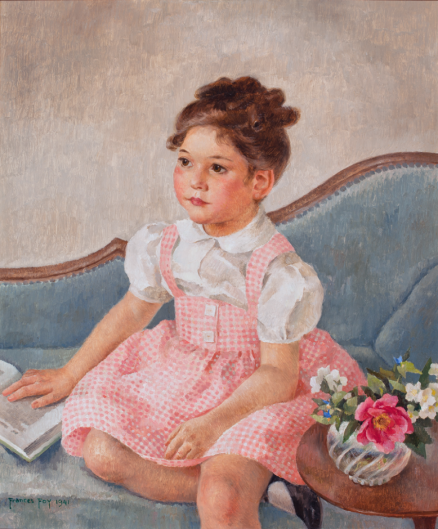- Categories
- Children
- Portraits
- Women artists
- Zoom in on Artwork
- Print Page
- Email Page to Friend
Portraits of children were a staple of Frances Foy’s artistic practice. In this example, she captured a little girl patiently posing in her formal best on a blue upholstered sofa. Complementing the tones of her pink-and-white checked jumper are several bright blossoms in a cut-glass bowl on a round table positioned between the figure and the viewer. Resting one hand on an open book, the sitter gazes off to the left as if she has just looked up from reading. Characteristic of Foy’s style are the delicate muted colors and the all-over patterned brushwork that lends a subtle vibration to surfaces. The diagonal curves etched into the glass bowl at the lower right echo the graceful line of the sofa back against the neutral background, while the rectilinear form of the book is repeated in the square buttons and checked pattern of the girl’s dress.
At the midpoint in her career, Foy was identified as an artist “who paints flowers, children and still life with delicate feeling and a pale, elusive color scheme.”i This work combines her characteristic subjects in what is most likely a commissioned portrait, as indicated by its solid realism and the formality of the little girl’s studied pose and Sunday-best attire. In the 1920s, Foy emerged as a modernist among Chicago artists with paintings that use expressive distortion of line and shape in images of everyday objects and scenes. This work, however, indicates her adaptability to more traditional standards of representation in a detailed and perhaps flattering portrayal of a specific individual. By the 1940s, Foy cultivated the favor of a mainstream public, regularly sending works on consignment to the art gallery at Marshall Field and Company department store, for example.
Wendy Greenhouse, PhD
Donated by M. Christine Schwartz to the Illinois State Museum, Springfield, Illinois, in 2021
i Daniel Catton Rich, “Chicago Painters,” American Magazine of Art 24 (Feb. 1932): 113.

